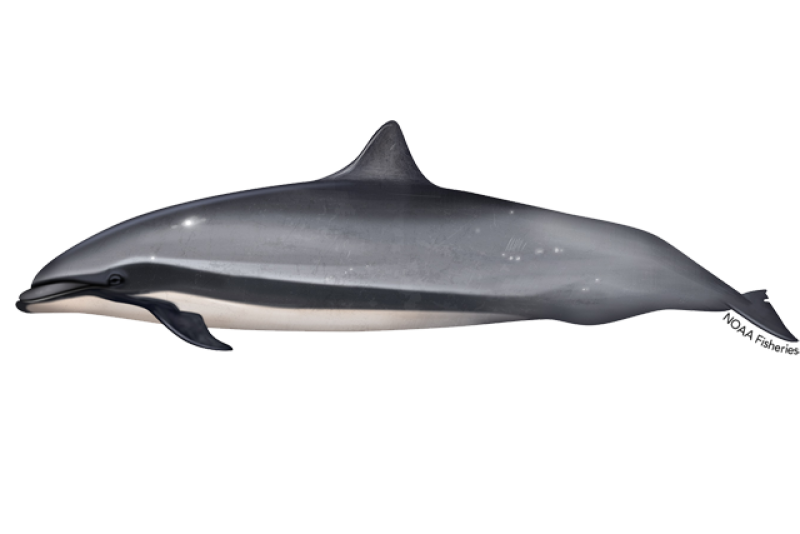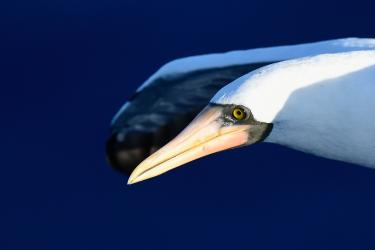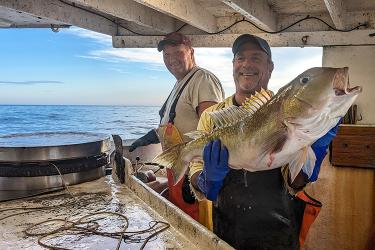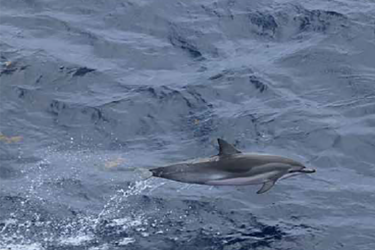Common Bottlenose Dolphin
Tursiops truncatus
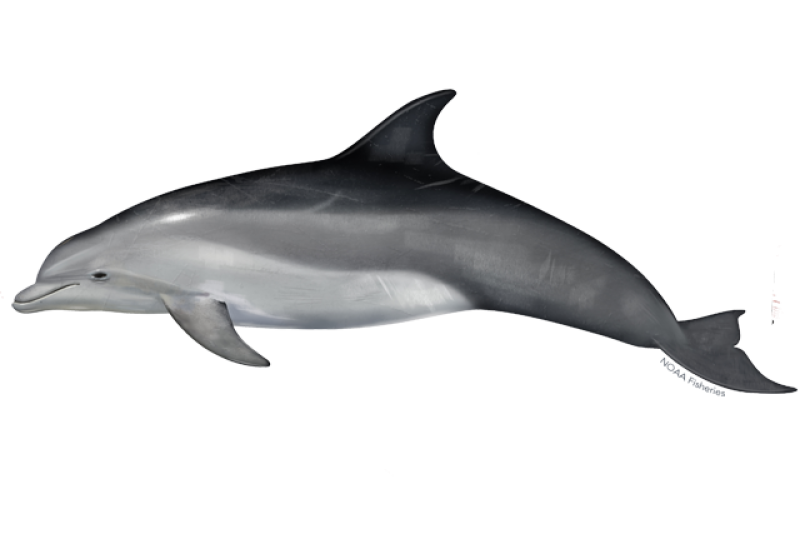
Protected Status
Western North Atlantic Central Florida Coastal stock
Western North Atlantic Northern Migratory Coastal stock
Western North Atlantic South Carolina-Georgia Coastal stock
Western North Atlantic Southern Migratory Coastal stock
Quick Facts
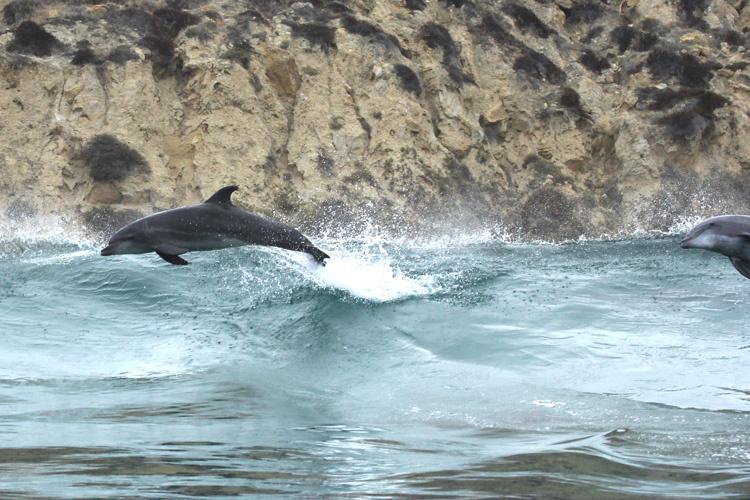 Common Bottlenose Dolphin. Credit: NOAA Fisheries
Common Bottlenose Dolphin. Credit: NOAA Fisheries
Common Bottlenose Dolphin. Credit: NOAA Fisheries
About the Species
 Common Bottlenose Dolphin. Credit: NOAA Fisheries
Common Bottlenose Dolphin. Credit: NOAA Fisheries
Common Bottlenose Dolphin. Credit: NOAA Fisheries
Common bottlenose dolphins (referred to hereafter simply as bottlenose dolphins) are found throughout the world in both offshore and coastal waters, including harbors, bays, gulfs, and estuaries of temperate and tropical waters (estuaries are the areas where rivers meet the sea). They are one of the most well-studied marine mammals in the wild. In addition, they are easy to view in the wild because they live close to shore and are distributed throughout coastal and estuarine waters. But this puts bottlenose dolphins at increased risk of human-related injuries and death. They are a highly intelligent species and use sound both for communication and to hunt for food.
Bottlenose dolphins in the United States are not endangered or threatened under the Endangered Species Act (ESA), but they are protected under the Marine Mammal Protection Act (MMPA). They are vulnerable to many stressors and threats including bycatch in commercial and recreational fisheries, disease, biotoxins, pollution, habitat alteration including increased freshwater exposure, vessel strikes, illegal feeding and harassment, energy exploration and oil spills, and other types of human disturbance, such as underwater noise.
NOAA Fisheries helps conserve bottlenose dolphins through collaborative management, integrated science, partnerships, and outreach. Our scientists use a variety of innovative techniques to study, protect, and rescue bottlenose dolphins in distress (e.g., disentanglement response and strandings). We facilitate collaborative approaches to better understand and reduce harmful effects of human activities on bottlenose dolphins and their habitat based on sound science, conservation, public input, and public outreach.
Population Status
Like all marine mammals, bottlenose dolphins are protected under the MMPA. NOAA Fisheries estimates population size for each stock of bottlenose dolphins in U.S. waters in stock assessment reports. In all, 81 stocks of bottlenose dolphins have been identified in U.S. waters. Population trends for many of the U.S. stocks are unknown. Five stocks along the Atlantic Coast are considered depleted under the MMPA.
Appearance
Bottlenose dolphins get their name from their short, thick snout (or rostrum). They are generally gray in color. They can range from light gray to almost black on top near their dorsal fin and light gray to almost white on their belly. Bottlenose dolphins living in nearshore coastal waters are often smaller and lighter in color than those living offshore.
Behavior and Diet
Bottlenose dolphins may travel alone or in groups, and the groups often break apart and reform. Their travel is characterized by persistent movement in a consistent direction. Resting is often characterized by tight group formations, slow movement, and intervals of methodical breathing.
Social behavior includes breeding, playing, aggression, and gentle body contact, such as rubbing. Calves maintain what is called “baby position” while swimming. In this position, the calf has easy access to nursing and may gain benefits by reducing drag from swimming in its mom’s slip stream. When in baby position, the mom surfaces first, and the calf surfaces slightly after and just behind and to the side of its mother.
Bottlenose dolphins can thrive in many environments and feed on a variety of prey, such as fish, squid, and crustaceans (e.g., crabs and shrimp). They use different techniques to pursue and capture prey, searching for food individually or cooperatively. For example, they work together to herd fish into groups and then take turns charging through the school of fish to feed. Bottlenose dolphins may also trap schools of fish against sand bars and seawalls for an easy meal. They use passive listening and/or high frequency echolocation to locate prey.
Instead of using their teeth to chew, bottlenose dolphins grip fish with their teeth, then swallow the fish whole—head first—so the spines of the fish don't catch in their throats.
Where They Live
Bottlenose dolphins are found in temperate and tropical waters around the world. They inhabit a wide variety of habitats, including harbors, bays, gulfs, and estuaries, as well as nearshore coastal waters, deeper waters over the continental shelf, and even far offshore in the open ocean. In the United States, bottlenose dolphins are found along the West Coast off California, Oregon, and Washington; in the Hawaiian islands; along the East Coast from Massachusetts to Florida; throughout the Gulf of America, and in the Caribbean.
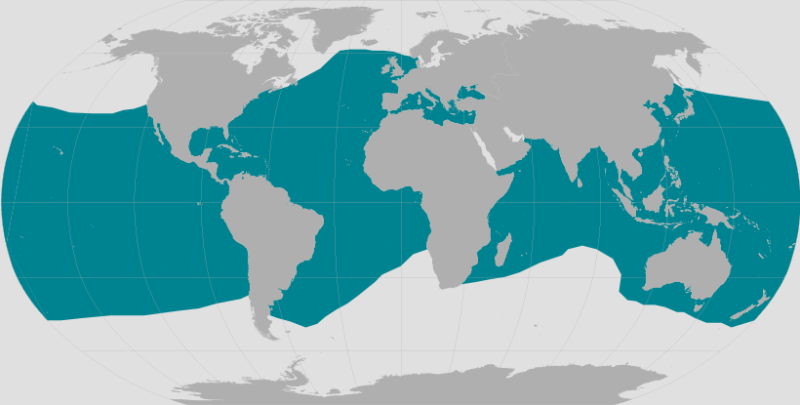 World map providing approximate representation of the common bottlenose dolphin's range.
World map providing approximate representation of the common bottlenose dolphin's range.
Lifespan & Reproduction
Bottlenose dolphins can live at least 40 years, with some females outliving males at 60 years or more. They generally begin to reproduce when they are between 5 and 15 years old, with the exact age varying by population. Female bottlenose dolphins can reach sexual maturity before males. Females are pregnant for about 12 months and give birth, on average, every 3 to 6 years. Once calves are born, they nurse for approximately 20 months and generally stay with their mothers for 3 to 6 years. Females as old as 45 have given birth.
Threats
Bottlenose dolphins are exposed to a variety of human-caused and natural threats and stressors. Some of the most pressing threats are discussed below.
Fisheries Interactions
One of the main threats to bottlenose dolphins is getting caught in fishing gear, known as bycatch. Bottlenose dolphins can become incidentally entangled, hooked, or otherwise captured in commercial fishing gear such as gillnets, seines, trawls, traps/pots, and longlines.
In addition to interactions with commercial fisheries, bottlenose dolphins may become entangled in or ingest rod-and-reel gear used by recreational anglers or for-hire fishing vessels, such as charter boats and headboats, which can lead to death or serious injury. This problem is increasing, especially in the southeastern United States and is largely the result of bottlenose dolphins taking bait and catch directly from fishing gear, eating discarded fish, or being fed fish (illegally) by humans, causing them to associate anglers with food. In addition, fishermen sometimes become frustrated when bottlenose dolphins take their catch and can retaliate with violence towards the dolphins.
Habitat Destruction and Degradation
Bottlenose dolphins living near shore are also susceptible to habitat destruction and degradation by contaminants and oil spills. For example, in areas with high levels of polychlorinated biphenyls (PCBs) bottlenose dolphin’s immune systems can be negatively affected. Bottlenose dolphins in areas affected by the 2010 Deepwater Horizon oil spill were found to have an impaired stress response, lung disease, and reproductive failure, among other health conditions (PDF, 685 pages). In addition to chemical contamination, physical habitat alteration due to shoreline development and infrastructure projects, increased freshwater exposure and freshwater diversion projects, and increased boat traffic are also of concern.
Biotoxins
Several bottlenose dolphin unusual mortality events (UMEs) have occurred in recent years, linked to harmful algal blooms (HABs), such as red tide. Several HABs (or several HAB-related die-offs) have been confirmed along the coast of Florida and others were suspected elsewhere in the Gulf of America. Bottlenose dolphins can be exposed to HAB toxins through the air or by eating contaminated prey. Biotoxin exposure can lead to both acute and more chronic health issues for bottlenose dolphins.
Illegal Harassment and Feeding Activities
Bottlenose dolphins are easy to view in the wild, but this also puts them at increased risk of human-related injuries and death. Feeding and attempting to feed bottlenose dolphins is not only illegal under the implementing regulations of the MMPA, but is harmful because it changes their behavior and reduces their wariness of people and vessels. They learn to associate humans with food and change their natural hunting practices by begging for handouts and taking bait/catch directly off fishing gear. Bottlenose dolphins, including calves, also learn these unnatural and risky feeding strategies from each other. Bottlenose dolphins are then more vulnerable to vessel strikes and to fishing gear entanglements and ingestion. They also may fall victim to extreme retaliatory acts, such as shooting, by frustrated boaters and fishermen.
Bottlenose dolphins may also be disturbed or harassed by the presence of humans and watercraft. Harassment is illegal under the MMPA and occurs when “any act of pursuit, torment, or annoyance has the potential to injure the animal or disrupt its behaviors." The implementing regulations of the MMPA further prohibit “the negligent or intentional operation of an aircraft or vessel, or the doing of any other negligent act which results in disturbing or molesting a marine mammal.” Any human-caused change to a bottlenose dolphin’s behavior may constitute disturbance or harassment. Long-term negative effects may include compromised health, reduced reproductive success, and displacement from or avoidance of important habitats.
Scientific Classification
| Kingdom | Animalia | Phylum | Chordata | Class | Mammalia | Order | Cetartiodactyla | Family | Delphinidae | Genus | Tursiops | Species | truncatus |
|---|
Last updated by NOAA Fisheries on 03/06/2025
What We Do
Conservation & Management
All bottlenose dolphins are protected under the Marine Mammal Protection Act. Some specific stocks in need of additional protections are designated as depleted or strategic. Our work supports the protection and conservation of bottlenose dolphins by:
- Reducing bycatch in commercial fisheries and recreational fisheries
- Minimizing harassment and illegal feeding
- Responding to dead, injured, or entangled dolphins
- Encouraging responsible viewing of wild dolphins
- Minimizing the effects of vessel disturbance, noise, and other types of human impacts
Science
NOAA Fisheries conducts research on the biology, behavior, and ecology of bottlenose dolphins to better inform management and policy. Examples include:
- Undertaking stock assessments to determine the status of populations and/or sub-populations
- Investigating unusual mortality events and strandings
- Examining population structure, abundance, and dynamics using a variety of research techniques including photo-identification and genetics
- Conducting natural resource damage assessments
How You Can Help
Prevent Rod-and-Reel Interactions
Serious and sometimes fatal dolphin injuries are on the rise from interactions with rod-and-reel fishing gear and boats. Here are some tips to prevent injuries to dolphins:
Never feed or attempt to feed wild dolphins or throw waste in the water.
Reuse or share leftover bait.
Reel in your line if dolphins are near.
Change locations if dolphins show interest in bait or catch.
Learn how to prevent injuries to dolphins when you are fishing
Keep Your Distance
Be responsible when viewing marine life in the wild. Observe all dolphins and porpoises from a safe distance of at least 50 yards and limit your time spent observing to 30 minutes or less.
Don't Feed Wild Dolphins
Dolphins fed by humans lose their natural wariness and learn to associate people with food, causing them to beg for handouts and take bait and catch directly from fishing gear. This puts them at risk from vessel strikes and becoming entangled in or ingesting fishing gear. Dolphins may teach these behaviors to their young, thereby putting them at risk.
More on protecting wild dolphins and admiring them from a distance
Report a Violation
Call the NOAA Fisheries Enforcement Hotline at (800) 853-1964 to report a federal marine resource violation. This hotline is available 24 hours a day, 7 days a week for anyone in the United States.
You may also contact your closest NOAA Office of Law Enforcement field office during regular business hours.
Featured News
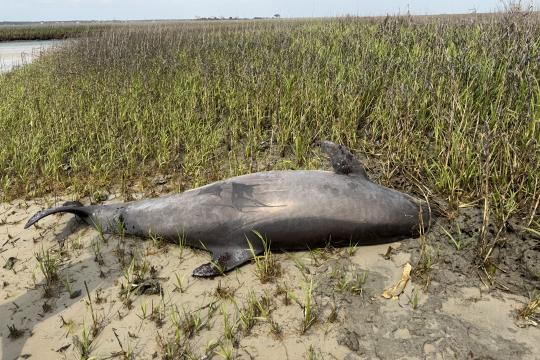 Stranded bottlenose dolphin in North Carolina marsh. Credit: UNCW
Stranded bottlenose dolphin in North Carolina marsh. Credit: UNCW
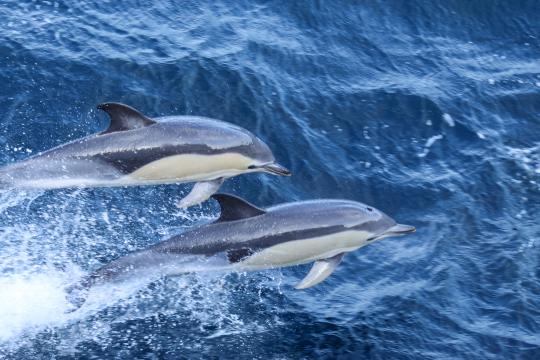 Common dolphins. Credit: NOAA Fisheries/Michelle Klein
Common dolphins. Credit: NOAA Fisheries/Michelle Klein
Celebrating 15 Years of Surveying Protected Species in the Northwest Atlantic
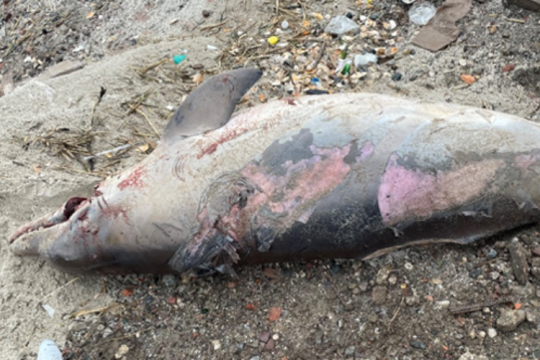 Bottlenose dolphin. Credit: New York State Department of Environmental Conservation
Bottlenose dolphin. Credit: New York State Department of Environmental Conservation
Dead Dolphin Found with Missing Fins and Tail in Queens, New York
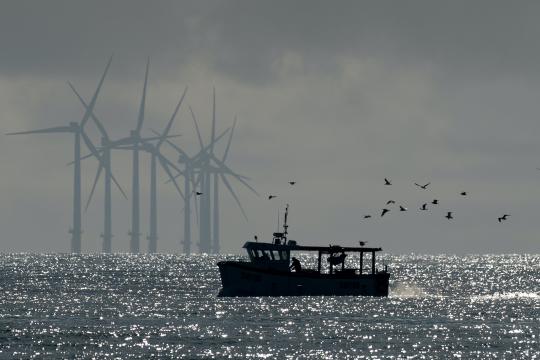 A small fishing vessel near wind turbines. Credit: Bob Brewer on Unsplash
A small fishing vessel near wind turbines. Credit: Bob Brewer on Unsplash
Studying Sound in the Ocean to Prepare for Offshore Wind Development
Management Overview
The common bottlenose dolphin is protected throughout its range under the Marine Mammal Protection Act.
The Western North Atlantic Northern Florida Coastal stock, Western North Atlantic Central Florida Coastal stock, Western North Atlantic Northern Migratory Coastal stock, Western North Atlantic South Carolina-Georgia Coastal stock, and the Western North Atlantic Southern Migratory Coastal stock are depleted under the Marine Mammal Protection Act.
Thirty-eight stocks in the Gulf of America, western North Atlantic, and Puerto Rico/U.S. Virgin Islands are also listed as strategic under the Marine Mammal Protection Act. To learn which stocks are designated as depleted and strategic, review the stock assessment reports for the common bottlenose dolphin.
Additionally, the common bottlenose dolphin is listed under:
- Appendix II of the Convention on International Trade in Endangered Species of Wild Fauna and Flora (CITES)
- Annex II of the Protocol for Specially Protected Areas and Wildlife (SPAW)
Although bottlenose dolphins live along the coast throughout the United States, our conservation and management work primarily focuses on the Gulf of
America and the western North Atlantic. Many stocks in these areas are listed as depleted and strategic and are exposed to numerous threats.
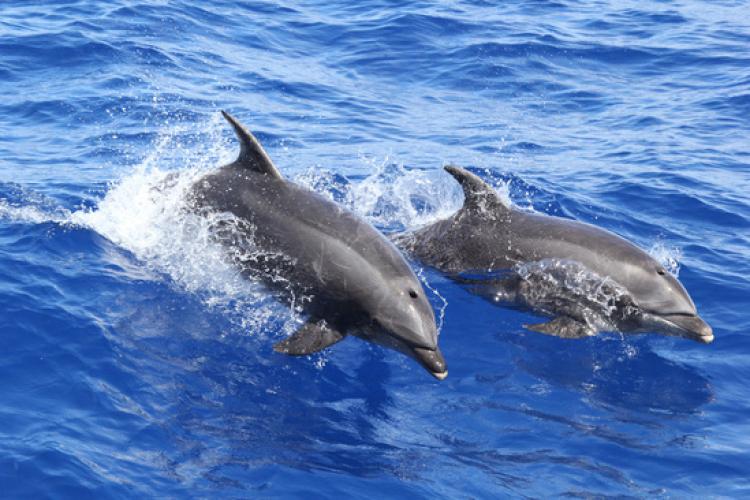
Conservation Efforts
Reducing Interactions with Fishing Gear
Bycatch in fishing gear is a leading cause of common bottlenose dolphin deaths and injuries. To reduce deaths and serious injuries of bottlenose dolphins from certain commercial fisheries in the western North Atlantic, NOAA Fisheries implemented the Bottlenose Dolphin Take Reduction Plan. Representatives from NOAA Fisheries, the fishing industry, regional fishery management councils, state and federal resource management agencies, the scientific community, and conservation organizations worked together to develop the plan. The plan includes gillnet regulations, such as seasonal gillnet restrictions, gear proximity requirements, and gear length restrictions. It also requires the use of modified pound net leaders for offshore Virginia pound nets in specified waters of the lower mainstem Chesapeake Bay and coastal state waters.
Learn more about bycatch and fisheries interactions
Reducing Rod-and-Reel Interactions
Interactions between bottlenose dolphins and rod-and-reel fishing gear used by recreational anglers are increasing. Bottlenose dolphins can be injured or killed by entanglement in or ingestion of the gear or may fall victim to retaliation from frustrated boaters and fishermen. NOAA Fisheries is working to better understand and characterize the frequency, geographic extent, and magnitude of these interactions. We are also working with researchers to identify and evaluate ways to safely and effectively reduce the potential for these interactions.
Minimizing Harassment and Illegal Feeding
As human interactions with wild bottlenose dolphins increase, so does the risk of disturbing or injuring these animals. NOAA Fisheries provides guidance on how to safely and responsibly view bottlenose dolphins, including the following initiatives:
Learn more about the rules regarding feeding and harassing marine mammals in the wild
Addressing Ocean Noise
Sound pollution threatens bottlenose dolphin populations by interrupting their normal behavior and driving them away from areas important to their survival. Increasing evidence suggests that exposure to intense underwater sound in some settings may cause some marine mammals, including bottlenose dolphins, to strand and ultimately die.
NOAA Fisheries is investigating all aspects of acoustic communication and hearing in marine animals, as well as the effects of sound on bottlenose dolphin behavior and hearing. In 2018, we issued updated marine mammal acoustic technical guidance for assessing the effects of anthropogenic sound on marine mammal hearing.
Overseeing Marine Mammal Health and Stranding Response
We work with volunteer networks in all coastal states to respond to marine mammal strandings including all dolphins and porpoises. When stranded animals are found alive, NOAA Fisheries and our partners assess the animal’s health and determine the best course of action. When stranded animals are found dead, our scientists work to understand and investigate the cause of death. Although the cause often remains unknown, scientists can sometimes attribute strandings to disease, harmful algal blooms, vessel strikes, fishing gear entanglements, pollution exposure, and underwater noise. Some strandings can serve as indicators of ocean health, giving insight into larger environmental issues that may also have implications for human health and welfare.
Learn more about the Marine Mammal Health and Stranding Response Program
Marine Mammal Unusual Mortality Events
Bottlenose dolphins have experienced multiple unusual mortality events (UMEs) in the past. Under the Marine Mammal Protection Act, a UME is defined as “a stranding that is unexpected; involves a significant die-off of any marine mammal population; and demands immediate response.” To understand the health of marine mammal populations, scientists study unusual mortality events.
Get information on active and past UMEs
Get an overview of marine mammal UMEs
Implementing the Dolphin-Safe/Tuna Tracking and Verification Program
Bottlenose dolphins, like other marine mammals, may become bycatch in fisheries. Some species of tuna are known to aggregate beneath schools of certain dolphin species. In some parts of the world, this close association led to the fishing practice of encircling a dolphin school to capture the tuna concentrated below, to the detriment of the dolphins, which often get entangled in the net. The Dolphin Protection Consumer Information Act established a national tuna tracking program to ensure that tuna imported into the United States meets certain requirements to ensure the safety of dolphins during tuna fishing operations.
Learn more about the Dolphin-Safe/Tuna Tracking and Verification Program
Key Actions and Documents
Last updated by NOAA Fisheries on 03/06/2025
Science Overview
NOAA Fisheries is committed to understanding the impacts of human activities on the biology and behavior of bottlenose dolphins. From population dynamics to the detection and monitoring of unusual mortality events, we are undertaking a range of studies to further our understanding of these animals.
Although bottlenose dolphins live off the coast throughout the United States, our research primarily focuses on stocks in the Gulf of America and the western North Atlantic.

Long-Term Studies of Estuarine Dolphins
Observational studies using photo-identification and other techniques play a key role in helping NOAA Fisheries understand the behavior and population dynamics of estuarine bottlenose dolphins and the threats they face. For example, The Sarasota Dolphin Research Program is the longest-running observational study of wild marine mammals in the world. Scientists have been collecting observational and photographic data from bottlenose dolphins in Sarasota Bay, Florida, continually for more than 50 years. Researchers from a range of fields—physiology, ecology, behavior, acoustics, genetics, and population dynamics—have used a variety of research methods to greatly increase our understanding of wild dolphin populations. With this information, we can better understand how to conserve and protect these marine mammals.
Damage Assessments
Understanding the effects of incidents such as oil spills is critical to predicting their long-term effect on wild bottlenose dolphin populations. For example, in response to the Deepwater Horizon oil spill, NOAA and local, state, and federal partners started the Barataria Bay, Louisiana, bottlenose dolphin study in 2010 as part of the Natural Resource Damage Assessment. A team of scientists reported a high rate of reproductive failure, among other things, in bottlenose dolphins exposed to oil from the Deepwater Horizon spill, having monitored bottlenose dolphins in Barataria Bay for 5 years. These insights provide a greater understanding of the challenges that wild dolphins face in Barataria Bay and elsewhere in the Gulf of America and throughout the United States.
Acoustic Science
Our research also is focused on acoustics—the physics of the properties of sound. We study the basic acoustic behavior of cetaceans and fish, mapping the acoustic environment and finding better ways to find cetaceans and their prey using acoustic technologies.
Learn more about acoustics science
Shipboard and Aerial Studies
NOAA Fisheries conducts research cruises and aerial surveys to collect information on bottlenose dolphins’ habitat preferences, feeding ecology, and distribution. Sea- and airborne surveys help us estimate the abundance of bottlenose dolphins in coastal and offshore waters, and study distribution shifts and trends over time.
Genetic Studies
Genetic sampling is used to study population structure, health, and prey preference. This type of information helps to better understand habitat use, population demographics, and the boundaries between different populations, which in turn helps to inform decisions for marine mammal management, conservation, and restoration planning to help protect these animals. Genetic sampling is also used to identify different species of bottlenose dolphin. For example, along the U.S. East Coast, two ecotypes of bottlenose dolphin are found, a coastal and an offshore form, and a recent study that incorporated both genetic and morphological data revealed that these two ecotypes in this area are separate species. The offshore form is the common bottlenose dolphin (Tursiops truncatus) and the coastal form is Tamenend’s bottlenose dolphin (Tursiops erebennus). In the western North Atlantic, the common bottlenose dolphin is found in deeper waters of the continental shelf break and beyond, and Tamenend’s bottlenose dolphin is found in nearshore coastal and estuarine waters from New York to Florida. The range extent of Tamenend’s bottlenose dolphin onto the continental shelf in the western North Atlantic, and beyond these waters (e.g., Gulf of America, Caribbean, and Bahamian waters) is not well-understood.
Stock Assessments
Determining the size of bottlenose dolphin populations helps resource managers determine the success of our conservation measures. NOAA Fisheries scientists collect population information from various sources and present the data in an annual stock assessment report.
As resources allow, NOAA Fisheries is also working with collaborators to update stock assessment reports for bays, sounds, and estuaries (BSEs) in the Gulf of America and the western North Atlantic. In the past 5 years, abundance studies were performed in several BSEs throughout the Gulf of America, including those in Louisiana, Alabama, and Florida.
Last updated by NOAA Fisheries on 03/06/2025
Documents
Photo-identification capture-mark-recapture techniques for estimating abundance of bay, sound and estuary populations of Bottlenose dolphins along the U.S. East Coast and Gulf of Mexico, a workshop report
The workshop sought to develop agreed upon best practices for fieldwork, photo processing and…
Report to Congress: Interactions between Bottlenose Dolphins and Sharks and Commercial, For-Hire, and Private Recreational Fisheries in the Gulf of America and South Atlantic
Report to Congress on interactions between bottlenose dolphins and sharks and fisheries in the Gulf…
Predicting the effects of low salinity associated with the Mid-Barataria Sediment Diversion project on resident common bottlenose dolphins (Tursiops truncatus) in Barataria Bay, Louisiana
Describes the development and application of the model that projects the impacts of exposure to low…
An Updated Literature Review Examining the Impacts of Tourism on Marine Mammals over the Last Fifteen Years (2000-2015) to Inform Research and Management Programs
In 2000, Samuels et al. provided a comprehensive review of the scientific literature available at…
Data & Maps
Bottlenose Dolphin Take Reduction Plan Map & GIS Data for New Jersey, Delaware and Maryland
Bottlenose Dolphin Take Reduction Plan Map & GIS Data for Northern and Southern Virginia
Bottlenose Dolphin Take Reduction Plan Map & GIS Data for Northern North Carolina
Research
Common Bottlenose Dolphin Ecotypes of the Western North Atlantic Revisited
Research proposing the recognition of a distinct species of coastal bottlenose dolphin.
Marine Mammal Photo-Identification Research in the Southeast
We use photos to identify, catalog, and study marine mammals in the Southeast. These photos provide important information about the health, social structure, abundance, and distribution of marine mammal populations.
Common bottlenose dolphin (Tursiops truncatus) abundance and distribution patterns in St Andrew Bay, Florida, USA
The goals of this study were to conduct photographic‐identification surveys during 2015 and 2016 to…
Population Consequences of the Deepwater Horizon Oil Spill on Pelagic Cetaceans
We quantified population consequences for pelagic cetaceans, including sperm whales, beaked whales,…
Outreach & Education
Protected Marine Species Identification Guide Southeast United States
This guide is intended for use by mariners in the identification and reporting of threatened and…
Dolphin Friendly Fishing Tips Sign
This sign is often posted near boat ramps, piers, docks, marinas, and waterfront parks.
Protect Wild Dolphins Sign
This sign is often posted near boat ramps, piers, docks, marinas, and waterfront parks.
Don't Feed Wild Dolphin Sign
This sign is often posted near boat ramps, piers, docks, marinas, and waterfront parks.
Last updated by NOAA Fisheries on 03/06/2025



